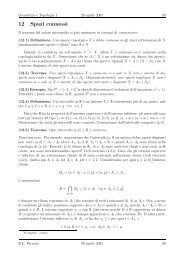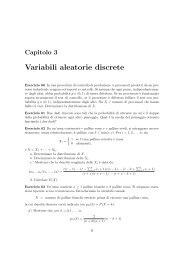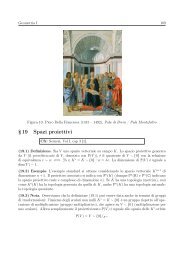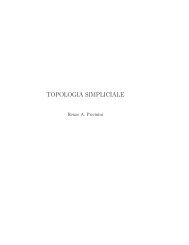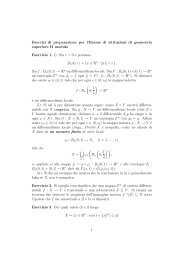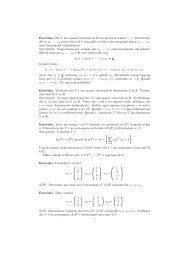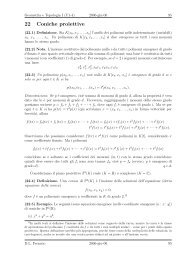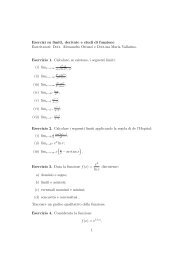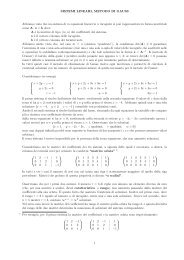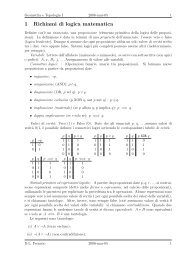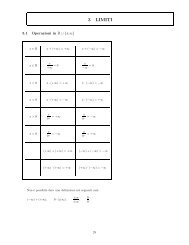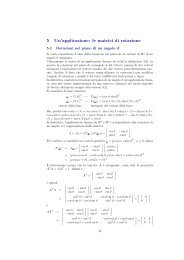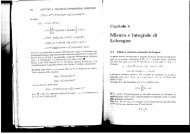Momenta of a vortex tangle by structural complexity analysis
Momenta of a vortex tangle by structural complexity analysis
Momenta of a vortex tangle by structural complexity analysis
Create successful ePaper yourself
Turn your PDF publications into a flip-book with our unique Google optimized e-Paper software.
Author's personal copy2224 R.L. Ricca / Physica D 237 (2008) 2223–2227Fig. 1. The area A <strong>of</strong> the projected graph resulting from the projection p ν <strong>of</strong>a <strong>vortex</strong> line L on the plane Π is proportional to the component <strong>of</strong> the linearmomentum <strong>of</strong> L in the ν-direction.arc-length s. Vorticity ω is defined on L i , and is simply given <strong>by</strong>ω = ¯ωX ′ , where, in general, X = X(s, t) denotes the positionvector, ¯ω a constant and t ≡ X ′ the unit tangent to L i (the primedenoting the derivative with respect to s, and t is time). Thelinear momentum P = P(T ) corresponds to the hydrodynamicimpulse, which generates the motion <strong>of</strong> T from rest, and fromits standard definition [11] takes the formP = 1 ∫X × ωd 3 X = 1 N∑Γ i X × X2 T2i=1∫L ′ ds, (1)iwhere P is here intended per unit density, and Γ i representsthe circulation <strong>of</strong> L i . Similarly, for the angular momentumM = M(T ), that corresponds to the moment <strong>of</strong> the impulsiveforces acting on T ; we haveM = 1 ∫X × (X × ω)d 3 X3 T= 1 N∑Γ i X × (X × X3∫L ′ )ds, (2)ii=1where, again, M is intended per unit density. We remark thatunder both Euler’s equations and LIA, we havedPdt= 0,dMdt= 0. (3)2. Interpretation <strong>of</strong> momenta in terms <strong>of</strong> projected areaArms and Hama [8], who first proved the conservation <strong>of</strong>the integral on the right-hand side <strong>of</strong> Eq. (1) for a single <strong>vortex</strong>line, showed that this quantity admits interpretation in terms <strong>of</strong>projected area (see Fig. 1). Indeed, <strong>by</strong> direct inspection <strong>of</strong> theintegrand above, it is evident that under LIA the plane projectedarea <strong>of</strong> the <strong>vortex</strong> line is proportional to the component <strong>of</strong>the linear momentum <strong>of</strong> the <strong>vortex</strong> along the direction <strong>of</strong>projection.Let p = p ν denote the orthogonal projection onto the planeΠ along the direction ν, and L ν = p ν (L) be the graph diagram<strong>of</strong> a smooth space curve L under p ν . Evidently L ν depends onν. For the moment let L ν be a smooth planar curve with noself-intersections, but in general L ν will be a nodal curve withself-intersections, the latter resulting from the projection <strong>of</strong> theapparent crossings <strong>of</strong> L, when L is viewed along the line <strong>of</strong>sight ν.By identifying the <strong>vortex</strong> line with its geometric support L,the projected graph diagram L ν will be oriented, the orientationbeing naturally induced <strong>by</strong> the vorticity vector. Let L xy , L yz ,L zx be the three graph diagrams <strong>of</strong> the projected <strong>vortex</strong> lineonto the mutually orthogonal planes x = 0, y = 0, z = 0,and let A xy = A(L xy ), A yz = A(L yz ), A zx = A(L zx ) be thecorresponding areas <strong>of</strong> the plane regions bounded <strong>by</strong> L xy , L yz ,L zx , respectively.By applying the results <strong>of</strong> Arms and Hama [8], from (1) wehaveP xy = Γ A xy , P yz = Γ A yz , P zx = Γ A zx , (4)where Γ is <strong>vortex</strong> circulation. Moreover:Definition 2.1. The resultant area A max is the maximal areaobtained <strong>by</strong> max ν p(A) = p max (A) (along the resultant axisν max ) among all possible projected areas A.The direction <strong>of</strong> the resultant axis ν max is clearly that <strong>of</strong> thelinear momentum. Hence, also from [8], we haveTheorem 2.2 (Maximal Area Interpretation). The resultantlinear momentum <strong>of</strong> a <strong>vortex</strong> line L, <strong>of</strong> circulation Γ , underLIA is given <strong>by</strong> P = Γ A max ν max , where A max is the resultantarea. The projected area <strong>of</strong> L on any plane perpendicular tothat <strong>of</strong> the resultant area is zero.Similar results hold true for the angular momentum. Withreference to the right-hand side <strong>of</strong> Eq. (2), the second integralcan be interpreted in terms <strong>of</strong> areal moment, according to thefollowing definition:Definition 2.3. The areal moment around any axis is theproduct <strong>of</strong> the area A multiplied <strong>by</strong> the distance d betweenthat axis and the axis a G , normal to A through the centroidG <strong>of</strong> A.For a <strong>vortex</strong> line L, the centroid G <strong>of</strong> the projected area A isthe center weighted with respect to the vorticity distribution <strong>of</strong>L. As for the linear momentum, the components <strong>of</strong> the angularmomentum are determined <strong>by</strong> the areal moments:M xy = Γ d z A xy , M yz = Γ d x A yz , M zx = Γ d y A zx , (5)where evidently d x , d y , d z are the distances between therotational axis and the centroid axes through A yz , A zx , A xy ,respectively. Similar considerations apply to define the resultantareal moment <strong>of</strong> L:Definition 2.4. The resultant areal moment <strong>of</strong> L is the arealmoment around the resultant axis a G <strong>of</strong> the projected areas <strong>of</strong>L onto two mutually orthogonal planes, parallel to a G .⋃These observations are easily extended to a <strong>tangle</strong> T =i L i <strong>of</strong> N <strong>vortex</strong> lines L i , provided we carefully define the



